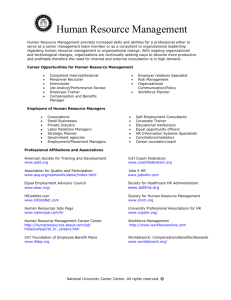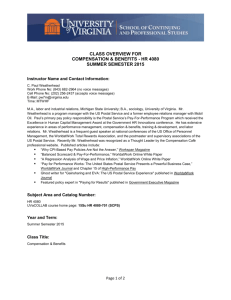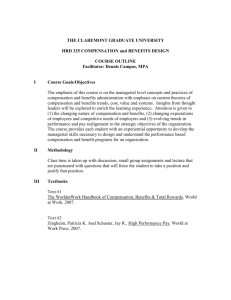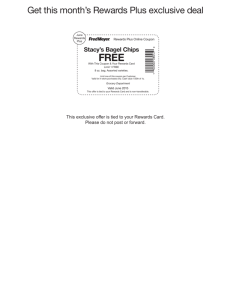2007 Model: Total Rewards & Practitioner
advertisement
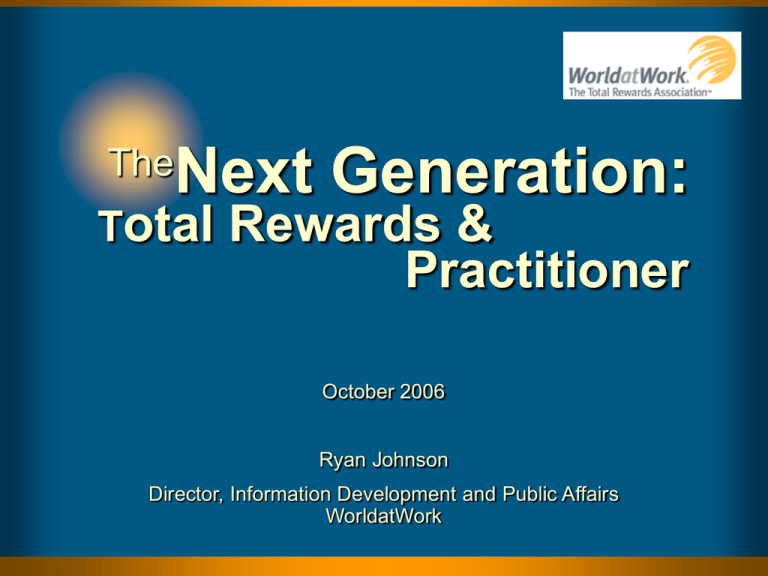
The Next Generation: Total Rewards & Practitioner October 2006 Ryan Johnson Director, Information Development and Public Affairs WorldatWork A little about my roles at the Association And … a little about WorldatWork The WorldatWork Evolution 1955 1958 1963 2000 Ohio Wage Midwest American & Salary Association Compensation Association Compensation Association WorldatWork Vision Vision Vision Vision Pay & job Pay & job Education & The global knowledge valuation valuation certification of and information leader in Ohio in Midwest compensation in employee rewards to professionals in improve organizational the USA performance Current WorldatWork Member Demographics Functional Area 5% All HR Functions 5% 2% Compensation Only 39% 19% Compensation & Benefits Benefits HR Specialty 30% A Non-HR Function Three Topics Today… The Theoretical The Next Generation of Total Rewards The Tangible The Next Generation Total Rewards Professional The Tactical The Three “Secret” WorldatWork Member Benefits That You Need to Take Advantage Of Part 1: The Theoretical The Next Generation of Total Rewards The New WorldatWork Model The Evolution of Rewards Pay Total Compensation Compensation • Base salary • Base salary • Position description • Variable pay • Base and variable pay • Incentives • Equity • Job evaluation • Executive equity • Incentives • Benefits Total Rewards • Compensation • Benefits • Work-life • Performance and recognition • Development and career opportunities Total Rewards Model 2000 – 05 Methodology of the New Model WorldatWork Strategy Committee Two years of discussion Focus groups, surveys, depth interviews Model had numerous iterations Approved by Board of Directors, 10/05 The 2006 WorldatWork Total Rewards Model Why a New Model? Evolution of the term “total rewards” Evolution in our membership Body of knowledge is being built What Do You Call It? More than 90% (combined) in our Sept. 2005 member survey said their organization talks about … “Total Rewards” “Total Compensation” or “Compensation and Benefits” Evolution of Total Rewards Concept Q: “How does your company define ‘total rewards’?” 56% comp, LTI, retirement, health care and welfare (‘everything with a measurable financial value’) 21% all financial rewards plus ‘quality of life’ 11% all financial and non-financial factors affecting employee’s experience, including job deployment 10% comp, LTI, and other cash based items 1% other Source: Deloitte 2006 Employee Rewards Survey Evolution of Total Rewards Concept Q: “Which of the following best describes how your company manages ‘total rewards’ (as you defined it previous question)?” 37% Concept is of interest, but no significant action taken 29% Comp, benefits and related functions work together on this concept and have a total rewards policy 22% Comp, benefits and related functions have discussed the concept and are considering further steps 8% We have a total rewards function that actively manages all rewards components as an integrated whole 4% Concept is not of interest to us at this time Source: Deloitte 2006 Employee Rewards Survey But still highly aspirational… Do health care cost increases enter into salary budget discussions? 73% “No” 19% “Yes, some impact” 8% “Yes, major impact recent years” Source: WorldatWork.org Quick Question, July 2006 (n=218) But there is also some good news… Just a few of the companies who now have employees with “total rewards” in their title… Sun Microsystems Johnson & Johnson H&R Block State Farm Ins. Target Corporation Heinz Verizon Burger King FedEx Qualcomm Pitney Bowes BP Blue Cross & Blue Shield The Gap Children’s Healthcare System Northrop Grumman Making the Model Tangible This model will be the basis for the association’s: Website and database organization Magazine content Research agenda A tool for you, academics, and anyone else interested in Total Rewards We know that integration is the hardest part… The University of Notre Dame Where is the TR leverage today? Which of the 5 elements is your biggest differentiator as an employer? 32% Benefits 23% Work-Life 18% Development & Career Ops 17% Compensation 10% Performance & Recognition Source: WorldatWork.org Quick Question, Sept 2006 (n=387) Section 2: Tangible The Next Generation of Professional What Your Peers Think What Does Success Look Like for Today’s Compensation Professional? Is it really simply advanced technical competence? Fact: Compensation is interacting with higher-level functions. “More interaction with CFO” 53% “More …with Comp Committee” 53% “More …with CEO” 51% “More …with legal” 47% Source: 2005 WorldatWork Survey “Changing Role of Compensation” Fact: What is valued and required of compensation professionals is changing. “More strategic thinking required” 76% “More understanding of company” 61% “More project management required” 52% “More business case development” 51% “More exec. presentations required” 47% Source: 2005 WorldatWork Survey “Changing Role of Compensation” Total Rewards / Compensation Professional Success Profile Question: Is there a “success profile” for a compensation/total rewards practitioner today? Results from 22 senior level practitioner interviews Company 1 Understand the business High personal integrity Knowledge and comfort with global economics and marketplace Ability to be flexible Do more with less Company 2 Cultivate relationships: finance, legal, tax and HR Knowledge of global labor/environ. trends Honed analytical skills for financial analysis and to support complex decision making Ability to consult, negotiate and sell Creative thinking Strong communication and facilitation skills Think holistically Be able to get over it Company 3 Understand changing demographics and what will motivate employees in the future Understand the business and impact of rewards decisions on the business Understand corporate governance Be creative, push the envelope Make principle-based decisions Company 4 Know the business of your company Accounting principles and selected areas of law Find comfort in an ever-changing landscape Creativity is highly valued Attention to detail is more important than ever Decisions, policies and practices must be well thought-out and documented Company 5 Understand your business Integrity Financial acumen Explain complex ideas in simple ways Know your audience and custom-build Strong writing skills Commitment Guts and Thick Skin Company 6 Study the implications of globalization Understand psychology and create or study data about employee preference Understand accounting and implications of C&B decisions on the business Vendor management Company 7 Comp staff will increasingly come and go from other areas of company Consulting skills Ethics and integrity Keys to becoming a leader: IQ, EQ, experience, potential Company 8 See beyond the market data See beyond the programs to objectives Global forces will change the way business is conducted in U.S. Need to understand and work with finance Company 9 Know business purposes and premises Think and act with very long time horizon Study interplay between design, tax, accounting, SEC, and ext. environment Know how compensation is leveraged just like a plant, or a marketing cost Know that your programs are no longer invisible outside of the company Company 10 Bias for action/results orientation Lead change Business and functional expertise Candor, challenge, feedback Interpersonal skills Savvy, street smarts Maturity and adoptability IMPORTANCE Leadership Managerial Technical Individual Contributor People Manager Director / Vice President Ten Key Takeaways 1. Technical competence is foundational 2. Knowledge of the business is as important as your compensation/TR skills 3. Know how to get things done 4. Communication/team skills are essential 5. Have and build a personal network of external peers Ten Key Takeaways 6. Know the organizational culture 7. Working knowledge of all areas of rewards 8. Be able to do more with less 9. Stay abreast of industry trends and new company practices and products 10. Bottom line: Constantly add value Section 3: The Tactical The Three Biggest Secrets of WorldatWork Membership That You Need to Take Advantage Of #1 33rd Annual Salary Budget Survey N=2,700+ across N. America Published August 1 2006: 3.8% across all ee categories and includes merit, general and COLA 1981: 10.5% 2007 projected: 3.9% Current CPI is 3.5% 33rd Annual Salary Budget Survey First Time Ever: Metro Area Data Data for both Dallas and Houston Dallas 3.8% (’06) 3.8% (proj. ’07) Houston 3.7% (‘06) 3.9% (proj. ’07) The survey also contains: 2006 and 2007 actual and projected merit, general/cola, total increase and months between increases for four employee categories 33rd Annual Salary Budget Survey Most Prevalent Attract + Retain Programs: Sign-on/Hiring Bonus 69% Spot Bonus 45% Retention Bonus 35% Part Time w/ Benefits 28% Variable Pay Usage: 79% Source: Salary Budget Survey, WorldatWork 2006 #2 New Survey Search tool Most common question into our Knowledge Center Online, multiple category searchable directory of more than 800 surveys Launched August 1 First month: more than 2,000 searches #3 HQ Library Database with 20,000 documents Knowledge Services knowledgecenter@worldatwork.org On-site Library at HQ One Final Thought… What would happen if senior management in every company viewed employee rewards as an investment to be managed, rather than a cost to be controlled? Questions? Ryan Johnson Director of Information Development and Public Affairs WorldatWork Direct: 480-905-5986 Email: rjohnson@worldatwork.org
